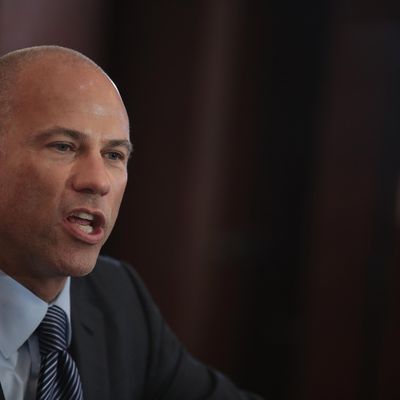
It’s becoming a truism in American scandals these days: You won’t have to look too far into a salacious, high-profile legal situation to find attorney Michael Avenatti involving himself in some capacity. On Monday, U.S. attorneys in New York and Los Angeles charged Stormy Daniels’s former lawyer with extortion and bank and wire fraud. Though the L.A. charges were fairly mundane — Avenatti allegedly hid from the IRS some $800,000 in money made from his coffee company — the extortion charge in New York involves the lawyer attempting to blackmail Nike over its alleged practice of paying NCAA recruits to attend schools they sponsored.
On Monday, Avenatti was arrested in New York, just minutes after tweeting that he would hold a press conference tomorrow to “disclose a major high school/college basketball scandal perpetrated by @Nike that we have uncovered.” But in his tweet, he did not mention that he allegedly attempted to extort the company out of some $26.5 million in exchange for staying silent. U.S. Attorney Nicola T. Hanna said that the bicoastal cases are unrelated, though prosecutors in California and New York worked together to arrest Avenatti and carry out search warrants simultaneously. Below, the nine most staggering details from the criminal complaints in New York and Los Angeles.
Avenatti wanted a $25 million retainer from Nike, and a $1.5 million payout for his client.
The FBI agent involved with the case states that Avenatti and an uncharged, unnamed co-conspirator (“CC-1”) “threatened to hold a press conference on the eve of Nike’s quarterly earnings call and start of the annual National Collegiate Athletic Association tournament at which he would announce allegations of misconduct by employees of Nike.”
Avenatti’s client is an AAU coach in California who was sponsored by Nike for $72,000. According to the criminal complaint, Nike recently decided not to renew the coach’s sponsorship, at which point he claimed he had evidence that Nike “employees had authorized and funded payments to the families of top high school basketball players” in a manner consistent with that of Adidas employees who were recently sentenced to nine months in prison for paying recruits to attend schools sponsored by their company.
According to the criminal complaint, “Avenatti stated that he would refrain from holding the press conference … only if Nike made a payment of $1.5 million to a client of Avenatti’s. … and agreed to “retain” Avenatti and CC-1 to be paid, at a minimum, between $15 and $25 million. Alternatively, and in lieu of such a retainer agreement, Avenatti and CC-1 demanded a total payment of $22.5 million from Nike … to buy Avenatti’s silence.”
Avenatti’s co-conspirator (“CC-1”) is reportedly Mark Geragos, who represented Colin Kaepernick and Jussie Smollett.
According to “a person with knowledge of the investigation” who spoke with the New York Times, Avenatti’s co-conspirator is Mark Geragos, the lawyer who represented Colin Kaepernick in his recently settled collusion case against the NFL. Geragos also represented Kaepernick in his contract negotiations with Nike, which made him one of the company’s highest paid football players. As the Times states, “Geragos, a CNN contributor, has a client list that has included Michael Jackson, Winona Ryder, Scott Peterson and most recently Jussie Smollett, the actor accused of fabricating a racist, anti-gay attack in Chicago.” As of Monday afternoon, Geragos was reportedly dropped as a contributor by CNN.
Avenatti to Nike: “I’ll go take ten billion dollars off your client’s market cap … I’m not fucking around.”
On March 20, 2019, Avenatti and the co-conspirator — allegedly Mark Geragos — spoke over the phone with attorneys for Nike, demanding the company submit to the payout deal. Avenatti gave Nike the above quote, one that is fairly consistent with the language of an alleged extortionist.
Avenatti to Nike: “A few million dollars doesn’t move the needle for me.”
According to the criminal complaint, in a phone call on March 20, Avenatti was frustrated by the Nike legal team’s attempts to stall: “I’m not fucking around with this, and I’m not continuing to play games … You guys know enough now to know you’ve got a serious problem. And it’s worth more in exposure to me to just blow the lid on this thing. A few million dollars doesn’t move the needle for me. I’m just being really frank with you.” The next day, in a meeting with Nike’s lawyers, Avenatti asked an attorney if he had ever “held the balls of the client in your hand where you could take five to six billion dollars off of the market cap?”
Avenatti to Nike: I don’t want to hear about a delay “unless somebody was killed in a plane crash.”
Avenatti and his co-conspirator agreed to meet with Nike on Monday, March 25, stating that he would hold his press conference on Tuesday if his demands were not met: “If this is not papered on Monday, we are done. I don’t want to hear about somebody on a bike trip. I don’t want to hear that somebody has, that somebody’s grandmother passed away or … the dog ate my homework. I don’t want to hear — none of it is going to go anywhere unless somebody was killed in a plane crash.” But Avenatti’s Monday turned out a little differently: He was arrested, minutes after tweeting about a press conference to announce Nike’s alleged misconduct.
According to the New York Times, “Prosecutors in New York said their investigation began only last week and was complete in days.”
Showing just how legally exposed Avenatti was in his alleged extortion attempt, his first contact with Nike was on March 19 — just six days later, he was under arrest.
In the Los Angeles case, Avenatti filed bogus tax returns from 2011 through 2013 to obtain loans from an FDIC bank in Mississippi.
The L.A. criminal complaint states that Avenatti provided the Peoples Bank in Biloxi, Mississippi, with false federal personal-income tax returns from 2011 to 2013, although “Avenatti never filed personal income tax returns for the 2011, 2012, and 2013 tax years.”
Avenatti allegedly cashed his client’s settlement money, told the client the money never came, and used it to pay for business expenses of his coffee brand, Tully’s.
According to the L.A. criminal complaint, in January 2018 — two months before filing a lawsuit against the president on behalf of Stormy Daniels — Avenatti arranged for a $1.5 million settlement to be transferred to a newly opened attorney trust account. The complaint states: “Rather than transfer his client’s portion of the settlement proceeds to his client, Avenatti used the entire $1.6 million for his own purposes, including to pay for expenses related to GBUS [the company which operated Tully’s Coffee]. Avenatti allegedly lied to his client, claiming that the settlement payment was not due until March 2018; when that deadline passed, Avenatti “led his client to believe that the $1.6 million payment had never been received.”
Avenatti may have hid $800,000 in coffee money from the IRS, and created an environment in which employees felt pressured to stay quiet.
According to the L.A. criminal complaint:
There is probable cause to believe that Avenatti took a number of affirmative cautions to obstruct an IRS collections action relation to GBUS’s unpaid payroll taxes, by among other things, lying to an IRS Revenue Officer … and instructing employees to deposit over $800,000 in cash from Tully’s stores … into a bank account associated with a separate entity to avoid liens and levies by the IRS.
A number of former BGUS employees have expressed concerns that Avenatti might attempt to retaliate against them if he learned they were cooperating with the government’s investigation.





